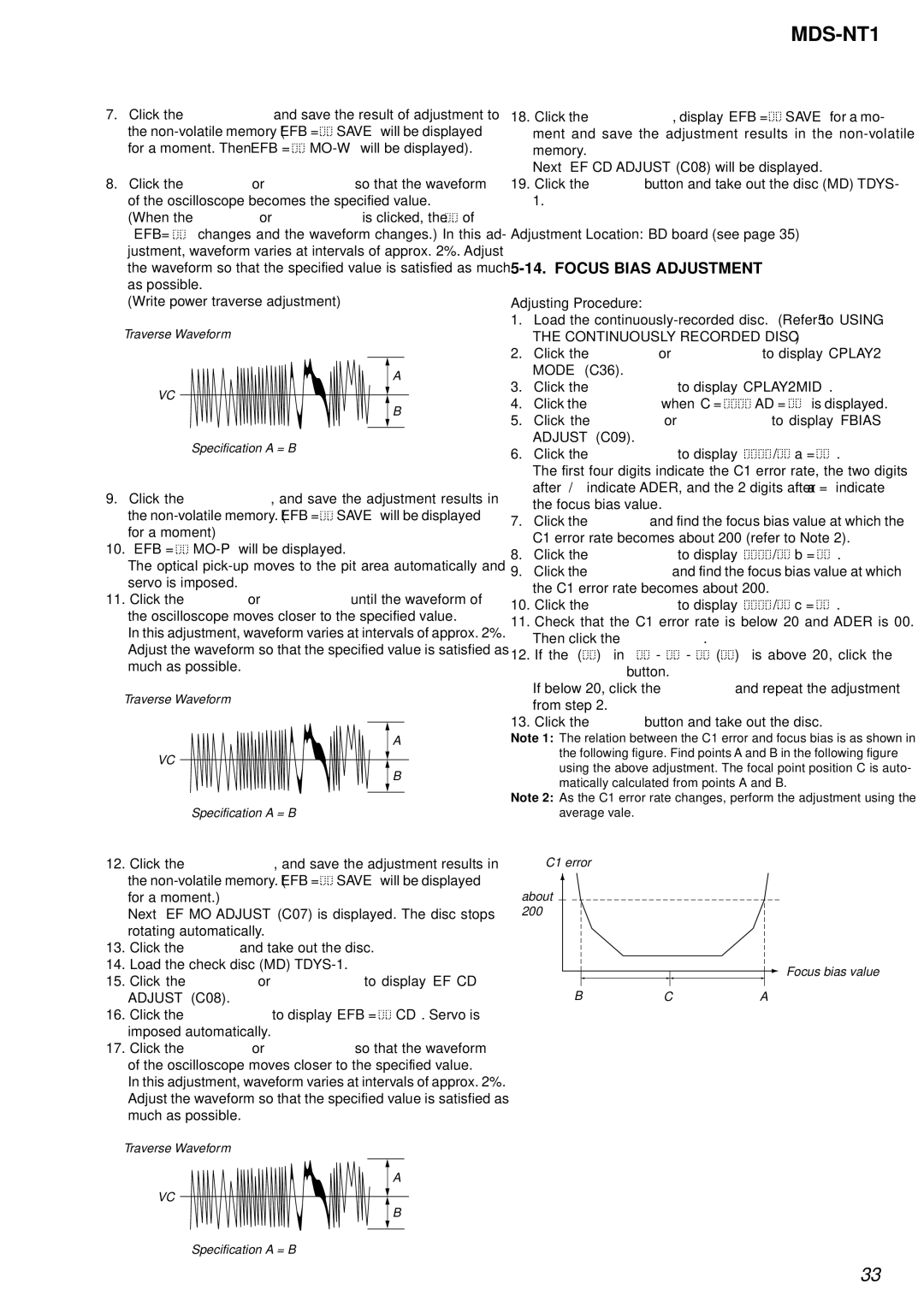
7.Click the [ENTER/YES] and save the result of adjustment to the ![]()
![]() SAVE” will be displayed for a moment. Then “EFB =
SAVE” will be displayed for a moment. Then “EFB = ![]()
![]()
8.Click the [JOG UP] or [JOG DOWN] so that the waveform of the oscilloscope becomes the specified value.
(When the [JOG UP] or [JOG DOWN] is clicked, the ![]()
![]() of “EFB=
of “EFB= ![]()
![]() ” changes and the waveform changes.) In this ad- justment, waveform varies at intervals of approx. 2%. Adjust the waveform so that the specified value is satisfied as much as possible.
” changes and the waveform changes.) In this ad- justment, waveform varies at intervals of approx. 2%. Adjust the waveform so that the specified value is satisfied as much as possible.
(Write power traverse adjustment)
Traverse Waveform
A
VC
B
Specification A = B
9.Click the [ENTER/YES], and save the adjustment results in the ![]()
![]() SAVE” will be displayed for a moment)
SAVE” will be displayed for a moment)
10.“EFB = ![]()
![]()
The optical
11.Click the [JOG UP] or [JOG DOWN] until the waveform of the oscilloscope moves closer to the specified value.
In this adjustment, waveform varies at intervals of approx. 2%. Adjust the waveform so that the specified value is satisfied as much as possible.
Traverse Waveform
A
VC
B
Specification A = B
12.Click the [ENTER/YES], and save the adjustment results in the ![]()
![]()
![]()
![]() SAVE” will be displayed for a moment.)
SAVE” will be displayed for a moment.)
Next “EF MO ADJUST” (C07) is displayed. The disc stops rotating automatically.
13.Click the [EJECT] and take out the disc.
14.Load the check disc (MD)
15.Click the [JOG UP] or [JOG DOWN] to display “EF CD ADJUST” (C08).
16.Click the [ENTER/YES] to display “EFB = ![]()
![]()
![]()
![]() CD”. Servo is imposed automatically.
CD”. Servo is imposed automatically.
17.Click the [JOG UP] or [JOG DOWN] so that the waveform of the oscilloscope moves closer to the specified value.
In this adjustment, waveform varies at intervals of approx. 2%. Adjust the waveform so that the specified value is satisfied as much as possible.
Traverse Waveform
A
VC
B
Specification A = B
MDS-NT1
18.Click the [ENTER/YES], display “EFB = ![]()
![]() SAVE” for a mo- ment and save the adjustment results in the
SAVE” for a mo- ment and save the adjustment results in the
Next “EF CD ADJUST” (C08) will be displayed.
19.Click the [EJECT] button and take out the disc (MD) TDYS- 1.
Adjustment Location: BD board (see page 35)
5-14. FOCUS BIAS ADJUSTMENT
Adjusting Procedure:
1.Load the
2.Click the [JOG UP] or [JOG DOWN] to display “CPLAY2 MODE” (C36).
3.Click the [ENTER/YES] to display “CPLAY2MID”.
4.Click the [MENU/NO] when “C = ![]()
![]()
![]()
![]() AD =
AD = ![]()
![]() ” is displayed.
” is displayed.
5.Click the [JOG UP] or [JOG DOWN] to display “FBIAS ADJUST” (C09).
6.Click the [ENTER/YES] to display “ ![]()
![]()
![]()
![]() /
/![]()
![]() a =
a = ![]()
![]() ”.
”.
The first four digits indicate the C1 error rate, the two digits after “/ ” indicate ADER, and the 2 digits after “a =” indicate the focus bias value.
7.Click the [JOG UP] and find the focus bias value at which the C1 error rate becomes about 200 (refer to Note 2).
8.Click the [ENTER/YES] to display “ ![]()
![]()
![]()
![]() /
/![]()
![]() b =
b = ![]()
![]() ”.
”.
9.Click the [JOG DOWN] and find the focus bias value at which the C1 error rate becomes about 200.
10.Click the [ENTER/YES] to display “ ![]()
![]()
![]()
![]() /
/![]()
![]() c =
c = ![]()
![]() ”.
”.
11.Check that the C1 error rate is below 20 and ADER is 00. Then click the [ENTER/YES].
12.If the “(![]()
![]()
![]()
![]() )” in “
)” in “ ![]()
![]()
![]()
![]() -
- ![]()
![]()
![]()
![]() -
- ![]()
![]()
![]()
![]() (
(![]()
![]()
![]()
![]() )” is above 20, click the
)” is above 20, click the
[ENTER/YES] button.
If below 20, click the [MENU/NO] and repeat the adjustment from step 2.
13.Click the [EJECT] button and take out the disc.
Note 1: The relation between the C1 error and focus bias is as shown in the following figure. Find points A and B in the following figure using the above adjustment. The focal point position C is auto- matically calculated from points A and B.
Note 2: As the C1 error rate changes, perform the adjustment using the average vale.
C1 error
about 200
Focus bias value
BCA
33
